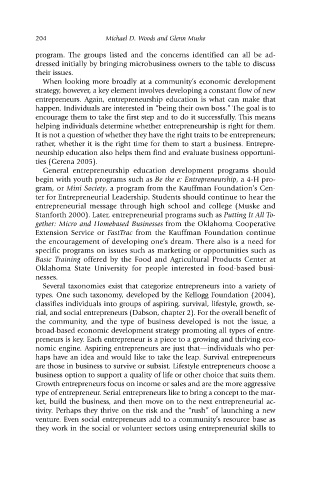Page 215 - 1-Entrepreneurship and Local Economic Development by Norman Walzer (z-lib.org)
P. 215
204 Michael D. Woods and Glenn Muske
program. The groups listed and the concerns identified can all be ad-
dressed initially by bringing microbusiness owners to the table to discuss
their issues.
When looking more broadly at a community’s economic development
strategy, however, a key element involves developing a constant flow of new
entrepreneurs. Again, entrepreneurship education is what can make that
happen. Individuals are interested in “being their own boss.” The goal is to
encourage them to take the first step and to do it successfully. This means
helping individuals determine whether entrepreneurship is right for them.
It is not a question of whether they have the right traits to be entrepreneurs;
rather, whether it is the right time for them to start a business. Entrepre-
neurship education also helps them find and evaluate business opportuni-
ties (Gerena 2005).
General entrepreneurship education development programs should
begin with youth programs such as Be the e: Entrepreneurship, a 4-H pro-
gram, or Mini Society, a program from the Kauffman Foundation’s Cen-
ter for Entrepreneurial Leadership. Students should continue to hear the
entrepreneurial message through high school and college (Muske and
Stanforth 2000). Later, entrepreneurial programs such as Putting It All To-
gether: Micro and Homebased Businesses from the Oklahoma Cooperative
Extension Service or FastTrac from the Kauffman Foundation continue
the encouragement of developing one’s dream. There also is a need for
specific programs on issues such as marketing or opportunities such as
Basic Training offered by the Food and Agricultural Products Center at
Oklahoma State University for people interested in food-based busi-
nesses.
Several taxonomies exist that categorize entrepreneurs into a variety of
types. One such taxonomy, developed by the Kellogg Foundation (2004),
classifies individuals into groups of aspiring, survival, lifestyle, growth, se-
rial, and social entrepreneurs (Dabson, chapter 2). For the overall benefit of
the community, and the type of business developed is not the issue, a
broad-based economic development strategy promoting all types of entre-
preneurs is key. Each entrepreneur is a piece to a growing and thriving eco-
nomic engine. Aspiring entrepreneurs are just that—individuals who per-
haps have an idea and would like to take the leap. Survival entrepreneurs
are those in business to survive or subsist. Lifestyle entrepreneurs choose a
business option to support a quality of life or other choice that suits them.
Growth entrepreneurs focus on income or sales and are the more aggressive
type of entrepreneur. Serial entrepreneurs like to bring a concept to the mar-
ket, build the business, and then move on to the next entrepreneurial ac-
tivity. Perhaps they thrive on the risk and the “rush” of launching a new
venture. Even social entrepreneurs add to a community’s resource base as
they work in the social or volunteer sectors using entrepreneurial skills to

